Results 1 to 10 of 16
-
01-06-2013, 04:35 PM #1Historically Inquisitive



- Join Date
- Aug 2011
- Location
- Upstate New York
- Posts
- 5,780
- Blog Entries
- 1
Thanked: 4249 Jean-Jacques Perret, sharpening,honing methods 1771
Jean-Jacques Perret, sharpening,honing methods 1771
Jean-Jacques Perret was a master cutler in France, he was born in 1730 in Beziers, France, son of a cutler, his adventure with cutlery started at the very young age of 12. After learning the trade Perret got involved with surgeons and his specialty quickly began towards surgical instruments.
Of course razors were a big part of surgical instruments at this in history and Perret was making some. In 1770 he wrote a book "La pogonotomie" or "the art of shaving oneself". In 1771 he wrote another book "L'Art du Coutelier" or the art of the cutler, this book goes into all phase of cutlery from metal choice to forging,grinding, etc.
One chapter of this book is about razors and how to choose the proper metal, cutting, forging, grinding, how to make and cut scales out of horn, wood etc. The most interesting part is the description of making the original bevel or "bevel setting". It is clearly written about choosing the correct stone for this application, and how the stone must be flat, and clean and the use of water or oil.
It is also explained about the sharpening stroke that one must use to set the bevel form on the razor, and the proper way to hold the razor while creating the bevel. Here the illustration of his razor stroke.
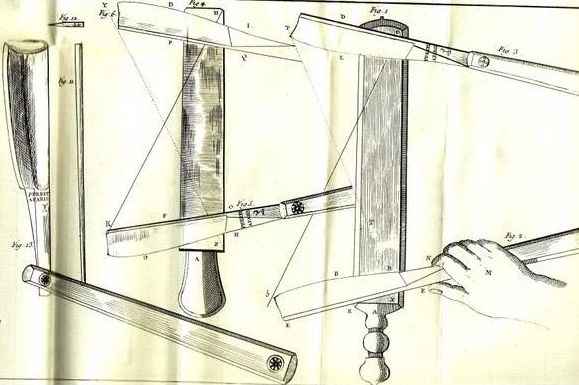
And another illustration of the honing stroke.
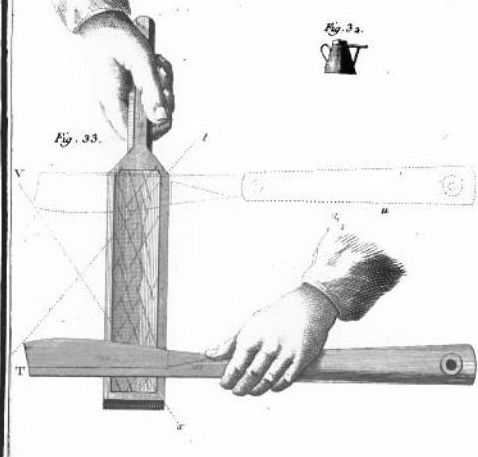
It is said to make many strokes untill the bevel is formed and when you think that each side joined each other, it is now time to test your results using a moist thumb nail and drag the edge on it slowly and it should be smooth and bitting, here the illustration of the thumb nail test method.
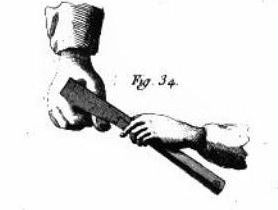
After a good test, he goes into polishing the bevel mainly on coticules.
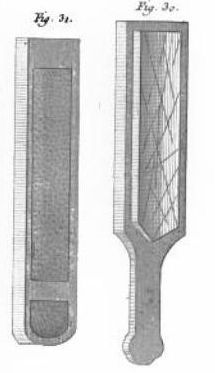
It was quite interesting to find this method still in uses today in such an old book, ive been told that the honing methods on SRP were based on old barbers manual but never found any that included setting the bevel.
Perret is also recoginze as the father of the safety razor, with a wooden attachement that he added to a razor like the picture below.
But i find that a little questionable. The attachement is at the bottom right corner last pic bottom, out of wood that would slide over the razor to only expose a little part of the blade and by the thickness of the wood and resting the wooden part of your face would make the correct angle for shaving.
And a pic of his razors.
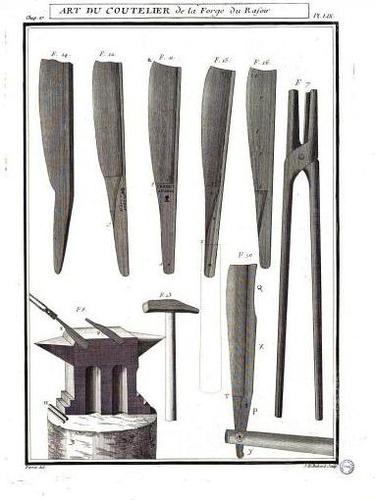
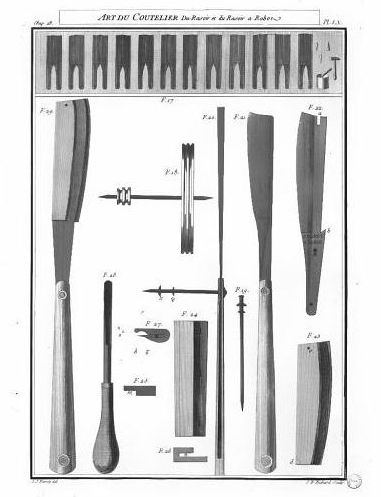
Another pic of Perret safety razor, his idea of it came from a wood plane.
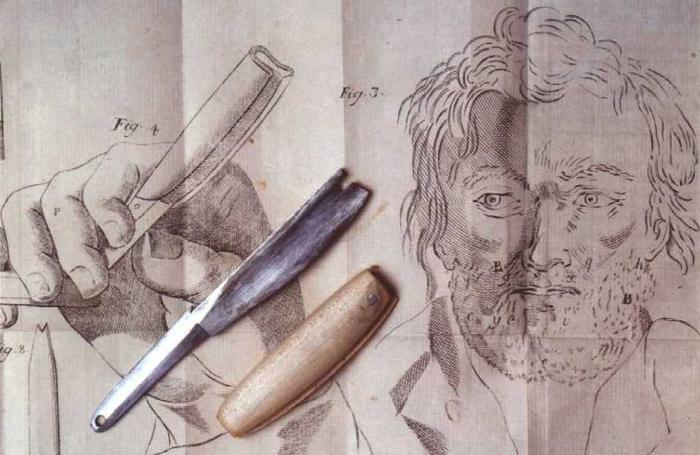
Last edited by Martin103; 01-06-2013 at 11:18 PM.
-
The Following 23 Users Say Thank You to Martin103 For This Useful Post:
Alaska (01-13-2013), Baxxer (01-06-2013), briarup (02-09-2014), Cangooner (01-07-2013), Double0757 (01-20-2014), DoughBoy68 (01-20-2014), engine46 (11-23-2015), Geezer (01-06-2013), gssixgun (05-20-2015), JimmyHAD (01-06-2013), Lemur (03-28-2013), Midoio (01-16-2013), MWS (01-13-2013), Neil Miller (05-20-2015), onimaru55 (03-28-2013), Proinsias (01-06-2013), randydance062449 (11-12-2013), RandyIdaho (03-18-2014), regularjoe (01-06-2013), seacaptainchris (12-12-2013), silverloaf (05-20-2015), Tarkus (01-06-2013), WW243 (05-20-2015)
-
01-06-2013, 04:44 PM #2Senior Member


- Join Date
- Dec 2011
- Location
- I'm Gonna Spend Another Fall In Philadelphia
- Posts
- 1,912
Thanked: 495
As always Martin thanks for the research material.
Funny for 240+ years later, were still striving for the same goals. To find the perfect bevel seting stone.
Har!!!
-
01-06-2013, 04:53 PM #3
 Re: Jean-Jacques Perret, sharpening,honing methods 1771
Re: Jean-Jacques Perret, sharpening,honing methods 1771
You continue to amaze me with the stuff you dig up Martin. Kudos!
When the Dude is recognized in the world, unDudeness will be seen everywhere--- the Dude de Ching
-
01-06-2013, 10:01 PM #4Historically Inquisitive



- Join Date
- Aug 2011
- Location
- Upstate New York
- Posts
- 5,780
- Blog Entries
- 1
Thanked: 4249
-
01-06-2013, 10:48 PM #5

Thank you! It was fun to chase down with Google and enjoy the rest of the book especially the illustrations. Modern tools are the same shape for a given function as back then.
Please keep 'em coming!
~Richard
-
01-06-2013, 11:00 PM #6Just a guy with free time.

- Join Date
- Oct 2011
- Location
- Mid state Illinois
- Posts
- 1,448
Thanked: 247
Does this mean someone has translated his books to english? I'd love to read them!
-
01-06-2013, 11:47 PM #7

Don't I wish! some parts were translated by Bernard Levine.
Here is a link to get the French language download, click on "Read ebook" then onto the download you want. If PDF click and fill out the capcha., About 4 minutes of DSL
~Richard
L'art du coutelier
Way too long a day for me, can't even get the phrasing right!
Enjoy!Last edited by Geezer; 01-07-2013 at 01:41 AM. Reason: Added link! Duh!
-
The Following User Says Thank You to Geezer For This Useful Post:
regularjoe (01-07-2013)
-
01-07-2013, 12:00 AM #8

Thanks Martin, fascinating. That's pretty much where I am now: setting the bevel, test, then polishing the bevel on coticules.
Edit: Geezer, maybe it's just been too long a day but I can't find a link in your post.
-
01-07-2013, 12:03 AM #9

I don't know about all of you, but that razor in the first few pictures is enormous
 lol. Setting that aside very informative. That looks like an early style barbers notch to be used with the safety cover. Wonder if that is how they started out and became just design to please the eye.
lol. Setting that aside very informative. That looks like an early style barbers notch to be used with the safety cover. Wonder if that is how they started out and became just design to please the eye.
Last edited by JSmith1983; 01-07-2013 at 12:12 AM.
-
01-07-2013, 12:14 AM #10Historically Inquisitive



- Join Date
- Aug 2011
- Location
- Upstate New York
- Posts
- 5,780
- Blog Entries
- 1
Thanked: 4249


 33Likes
33Likes LinkBack URL
LinkBack URL About LinkBacks
About LinkBacks






 Reply With Quote
Reply With Quote


